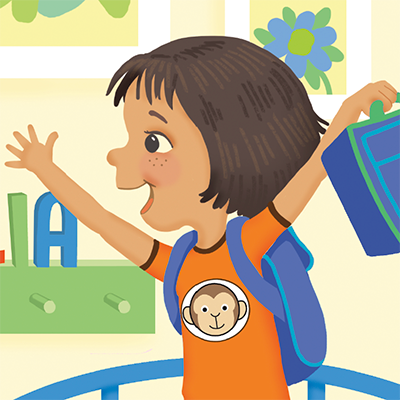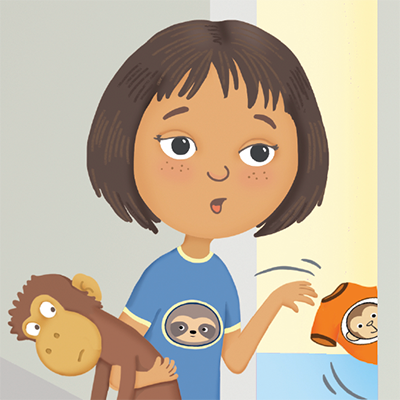From Sketches to Full Color
- Esther Harder

- Dec 26, 2020
- 5 min read
Updated: Dec 29, 2020
Author-Illustrator Collaboration, Part II
From sketches, we moved into full-color page renderings of Quarantine Kids!
Dana sent me full-color pages in weekly batches for review. I quickly realized that illustration has a lot of behind-the-scenes effort that takes a significant amount of time; in this story's outdoor setting, for example, bricks had to be drawn into the apartment wall. Scenes on the balconies take place from different perspectives, so it wasn't a simple matter of placing the bricks straight on; in some scenes, they are at more of an angle, and had to be redrawn.
As readers, we don't typically spend our moments counting each brick or thinking about how the illustrator created them so symmetrically. We would notice if they were out of alignment or missing entirely, however. It was a feat of patience waiting for those bricks to be laid!
Editorial Process on Full-Color Pages
In the sketch stage that we completed, I ensured that illustrations were set up to convey the general feeling I wanted.
In these full-color renditions, the items I was checking on got a whole lot more complex:
Characterization: Were characters being portrayed as I imagined?
Plot: Were illustrations helping to build the action toward the climax?
Layers: I worked in some details that are hidden in the illustrations for readers to discover upon closer analysis. Were those coming through properly?
Consistency: Did details stay in the same location across pages? Were the illustrations contradicting the text in any way?
Characterization
While my main goal is to tell a good story that readers will want to keep coming back to, another goal is to share a hopeful message: As isolated and hemmed in as we might feel, our potential for imagination cannot be contained by physical boundaries.
This message influenced the characters I chose and how I portrayed the COVID-19 pandemic.
First of all, I wanted this story to remain a fictional, fun story, so I decided to use the pandemic as a source of constraint, not the main conflict. The pandemic limits Elia's play options to her apartment; Elia's mom redirects Elia to play on their balcony so that she can complete her work calls with some decorum.
From there, the story becomes more about what Elia will find to do than how Elia struggles with COVID-19 specifically. To stay more broadly relevant so that this book can be read in years to come, the story mentions “germs,” but does not name COVID-19 or the pandemic. Masks are used briefly, but as a source of imaginative play, not as a response to health guidelines. Through all of these decisions, I hoped to keep the focus on the characters and their play.
The next important part of characterization was to show that potential for imagination is unlimited. Everyone can engage in imaginative play! To illustrate this, I created characters who represented a variety of ages, ethnic backgrounds, and physical abilities, similar to the families we meet in our apartment community. I specifically chose to have Elia, my protagonist, be from a Mexican family because my husband and infant son are of Mexican heritage.
Plot
The main source of tension in this story is the internal question for Elia of whether she will dig into her imagination and create something fun to do. Once she is out on the balcony, Elia makes a series of attempts to play with other children, but for one reason or another, their choice of play does not really suit her.
The illustrations undergird the plot arc by showing Elia's growing interest and imaginative contributions into the outdoor play. While her first interactions are more tentative, by the end of the book, she creates a full-blown, one-of-a-kind activity all of her own.
I was curious to see how the dramatic tension between what is actually going on from an adult perspective—children are out safely playing on their respective balconies and calling to each other across the building—and what the children are imagining would be illustrated in one static scene. For example, at one point, Elia becomes a whale to rescue her friends from a sea monster, so she soars up to their balcony to sweep them from the kraken's clutches. The illustrations have to show Elia with both feet on her balcony to satisfy adult safety concerns, while at the same time, Elia the whale soars out of her balcony and up to save her neighbors from watery doom. I'm no objective reader, but I think the artistic interpretation of this interplay is very successful.
Layers
Picture books are a whole lot more interesting when there are things that are going on in the illustrations that are not described in the text. My favorite picture books are those that have little secrets or sub-plots buried in the illustrations. Some illustrators hide a character on all pages, and create a seek-and-find for readers. Others might have secondary characters having their own quiet plot arc in the background. I wanted to play with adding depth to my book in this manner.
One characteristic I gave Elia early on is the idea that she likes to have her shirts match her moods. When we are first introduced to her, she's wearing a monkey T-shirt because she is so excited. She knows it's Monday, and Monday means school and friends and so much action...except when it doesn't. Mom reminds Elia that school is still closed. Then, Elia and her mother talk through alternative fun options for the day, and when Elia realizes that all her usual favorite places are off-limits due to the germs, her mood deflates and she changes into a sloth shirt. From those first hints, I am hoping readers will be curious to see what shirts Elia puts on next as she starts her balcony adventures.
Another layer is Elia's monkey sidekick. The monkey remains a stuffed animal no matter what adventure they take part in, but if you watch the monkey's eyes closely, it tracks Elia's movement and even mimics her expression. This helps to blend the boundaries between what is actual and imagined.
Consistency
Keeping page elements consistent was the most difficult aspect to watch out for. Dana did a great job in carrying across themes and colors, and the like, but because I received the pages in batches, sometimes I would request a change on one page that impacted a lot of other pages, and keeping track of all those interdependencies was a huge challenge, particularly because by that time, I had looked at the pages a number of times—for line edits, for rough sketches, for general details of the full colors, etc.—so it was difficult to notice the minute inconsistencies an edit might create.
This is a step of the process where it helped to have beta readers who came to the story with a fresh perspective and could analyze the pages one by one. They pointed out things like a missing monkey on one page, or an incorrect shirt on another. Nothing's too small, I told them, and they really came through!
Get it Covered
Once I was happy with all the inner illustrations, we moved on to cover design and layout. I knew my cover needed to be a wide-angle view of Elia and her friends interacting on their balconies, but without the interference of the imaginative elements. I wanted to keep this introduction to the characters pared down, so that the main thing that a reader gets when scanning the cover is that this story will take place on apartment balconies, which might spur curiosity as to how the "quarantine" of "Quarantine Kids" fits in.
On the back, I needed to fit my book summary, our author/illustrator bios, and the ISBN. (I wasn't creating a dust jacket, which is where some of that text often goes.) I knew that I had created a text-heavy back cover, so I was not expecting to fit much more there in the way of illustration, just a lot more bricks.
It turned out that since Dana was illustrating in Photoshop, we could pull images from a couple other pages and reposition slightly to create just what I envisioned! That done, we were on our way to sending files off to the printer to start the production process.












Thank you for sharing your process and insights! Very interesting.